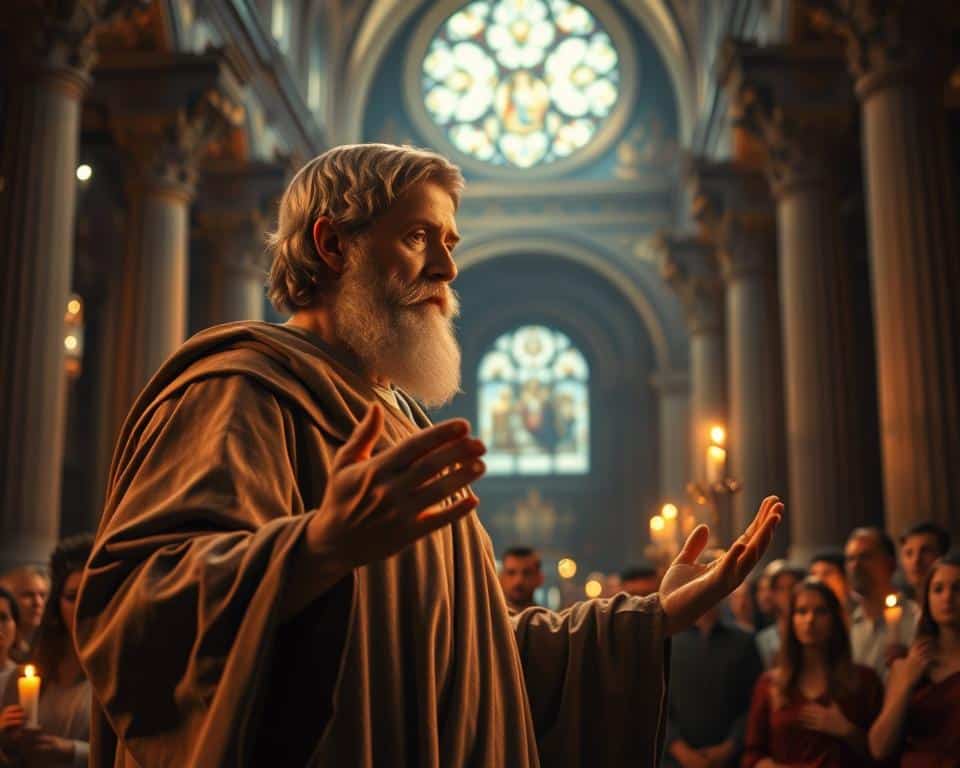Have you ever wondered what the gospel truly reveals about His journey? The accounts in Scripture offer profound insights into His purpose and teachings. This article uncovers seven biblical truths that illuminate His path and message.
From His humble beginnings in Bethlehem to His ministry, the gospel provides a clear picture of His mission. Writers like John and others documented His words and actions with care. These records help us understand His role and the hope He brings.
By exploring these truths, you’ll gain a deeper connection to God’s word. Let’s dive into the scriptural teachings that reveal His purpose and impact.
Early Beginnings: Birth and Family Background
The story of His beginnings is rooted in humility and simplicity. Born in Bethlehem, His arrival was marked by modest circumstances. This small town, known for its historical significance, became the starting point of His journey.

After His birth, His family moved to Nazareth, a quiet village in Galilee. Here, He grew up in a working-class household. His legal father, Joseph, was a carpenter, reflecting the family’s simple lifestyle.
Bethlehem and Nazareth Origins
Bethlehem, the place of His birth, fulfilled ancient prophecies. This town, mentioned in Micah 5:2, was a key part of God’s plan. Later, Nazareth became His childhood home, shaping His early years.
Family Heritage and Early Life
His family heritage traces back to King David, as recorded in Luke and Matthew. This lineage highlights His rightful place in history. His upbringing in Nazareth, surrounded by faith and simplicity, prepared Him for His future mission.
These early years set the stage for His later teachings. The values He learned in His family and community became the foundation of His message. By understanding His beginnings, we gain deeper insight into His purpose.
Virgin Birth and Prophecies Fulfilled
The virgin birth stands as a testament to divine intervention. This miraculous event, recorded in Matthew and Luke, shows God’s power at work. It was not just a birth but the fulfillment of ancient promises.

Mary’s Experience of the Miracle
Mary, a young woman from Galilee, received news that would change her life. The angel Gabriel told her she would bear a child through the Holy Spirit. Despite the challenges, she accepted God’s plan with humility and faith.
Her response, “Let it be to me according to your word,” reflects her trust in God. This moment highlights the importance of obedience and faith in His promises.
Old Testament Prophecies in Micah
The prophecy in Micah 5:2 foretold that the Messiah would be born in Bethlehem. This small town became the birthplace of the Savior, fulfilling God’s word. The connection between prophecy and reality strengthens our faith in Scripture.
These events show that God’s plan is precise and trustworthy. From the virgin birth to the fulfillment of prophecies, every detail points to His divine purpose.
The Infant Years and Early Challenges
The early years of His journey were marked by trials and divine guidance. From the moment of His birth, His family faced unexpected dangers. These events tested their faith and revealed God’s unwavering protection.
Escape to Egypt for Safety
King Herod’s decree to kill infant boys forced His family to flee to Egypt. This urgent decision was a matter of life and death. The journey was perilous, but God’s providence ensured their safety.
During this time, His family relied on their faith to navigate the uncertainty. Egypt became a temporary refuge, far from the dangers in Jerusalem. This event fulfilled prophecies and highlighted God’s plan.
Return to Nazareth
After Herod’s death, His family returned to Nazareth. This small town in Galilee became their home once again. Here, He grew up in a community rooted in faith and simplicity.
Re-establishing their life in Nazareth was a step toward fulfilling His purpose. This period of His early years shaped His understanding of God’s word. It also prepared Him for the mission ahead.
These events remind us that even in times of danger, God’s protection is steadfast. His family’s journey is a testament to the power of faith and obedience.
Jesus’ Early Ministry: Baptism and Testing
The start of His public ministry was marked by two pivotal events: baptism and testing. These moments not only revealed His divine purpose but also set the tone for His mission. Through these experiences, He demonstrated unwavering faith and obedience to God’s word.
John the Baptist’s Influence
John the Baptist played a crucial role in preparing the way for His ministry. Known for his bold preaching, John called people to repentance and baptized them in the Jordan River. When He came to be baptized, John recognized His greatness, saying, “I need to be baptized by You.”
This act of baptism was a public declaration of His divine sonship. As He emerged from the water, the heavens opened, and a voice declared, “This is My beloved Son, in whom I am well pleased.” This moment affirmed His identity and mission.
Desert Temptations and Lessons
Immediately after His baptism, He was led by the Spirit into the desert for 40 days of testing. Here, He faced intense temptations from the enemy, each challenging His resolve and adherence to God’s word. Despite physical weakness from fasting, He stood firm.
He overcame each temptation by quoting Scripture, showing the power of God’s word in times of trial. This period of testing prepared Him for the challenges ahead and reinforced His commitment to His mission. It also taught us the importance of relying on God’s truth in our own lives.
These events marked the official beginning of His ministry. They remind us that even in moments of testing, God’s presence and word provide strength and guidance.
First Miracles and the Call of the Disciples
A wedding in Cana became the stage for a miraculous event. This was the first public sign of His divine authority, recorded in the Gospel of John. It revealed His compassion and power, drawing many to follow Him.
Water into Wine at Cana
At the wedding, the hosts ran out of wine. His mother, Mary, brought this concern to Him. Though He initially hesitated, He instructed the servants to fill six stone jars with water. When they drew from the jars, the water had turned into the finest wine.
This miracle was more than a display of power. It symbolized transformation and the abundance of God’s grace. The master of the feast remarked, “You have kept the good wine until now.” This act deepened the faith of His disciples and those who witnessed it.
Recruiting the First Followers
After this miracle, He began to call His first disciples. Among them were fishermen from Galilee, including Simon Peter and Andrew. They left their nets to follow Him, marking the start of a journey that would change their lives.
These ordinary men were chosen for an extraordinary purpose. Their decision to follow Him showed trust in His teachings and mission. This moment laid the foundation for a ministry that would reach far beyond Nazareth and Galilee.
Through these events, we see His commitment to truth and the power of God’s word. His first miracles and the call of His disciples remind us of the hope and transformation He brings to our lives.
Teachings and Parables in Galilee
In the heart of Galilee, timeless truths were shared through simple yet profound stories. These teachings, rooted in everyday life, continue to inspire and guide believers today. The parables He used were not just stories but powerful lessons about God’s kingdom and love.
Galilee, with its bustling towns and serene landscapes, provided the perfect backdrop for His message. Here, He spoke in ways that resonated with people from all walks of life. Farmers, fishermen, and families could relate to the imagery He used, making His teachings accessible and meaningful.
Simple Stories with Deep Meaning
He often used parables to explain complex truths in a way that everyone could understand. For example, the Parable of the Sower illustrates how God’s word takes root in different hearts. Some seeds fall on rocky ground, while others find fertile soil, yielding a harvest of thirty, sixty, or a hundred times.
These stories were designed to reach people in their daily lives. They addressed common struggles and offered hope. By using familiar settings and characters, He made His message relatable and impactful.
Even today, these parables continue to offer guidance. They remind us of the importance of faith and the transformative power of God’s word. Whether it’s a lesson about forgiveness or the value of persistence, His teachings remain relevant in every day and every world.
As we reflect on these stories, we see how they point to a greater truth. They reveal God’s love and His desire for us to live in harmony with His will. Just as He used parables to teach, we can use His words to navigate life’s challenges and grow in our faith.
Confrontations with Religious Leaders
Throughout His ministry, He faced significant opposition from religious leaders, challenging their traditions and authority. These encounters highlighted His commitment to truth and His mission to restore true worship. One of the most dramatic moments was the temple clearing event, which revealed His unwavering dedication to God’s house.
The Temple Clearing Event
When He entered the temple, He found it filled with merchants and money-changers. This commercial activity had turned a place of worship into a marketplace. With righteous anger, He overturned their tables and drove them out, declaring, “My house shall be called a house of prayer, but you have made it a den of thieves.”
This act was not just about restoring order. It demonstrated His uncompromising commitment to God’s house. The religious leaders, however, saw His actions as a threat to their authority. They questioned His right to challenge their practices, but He stood firm in His mission.
John Baptist had prepared the way for these confrontations by calling people to repentance. His bold preaching set the stage for the truth He would bring. The temple clearing event pointed to a deeper need for spiritual renewal, reminding us that true worship comes from the heart.
These confrontations reveal the importance of standing for truth, even when it challenges established traditions. They remind us that God’s word is the ultimate authority, guiding us to live in faith and obedience.
A Closer Look at the Gospel Narratives
The four gospels provide a rich and diverse view of His mission. Each writer—Matthew, Mark, Luke, and John—offers a unique perspective, yet they all share a common thread of hope and redemption. Understanding these narratives deepens our grasp of God’s word and its timeless truth.
Matthew’s gospel emphasizes His role as the Jewish Messiah, fulfilling Old Testament prophecies. Mark, the shortest gospel, focuses on His actions and miracles, presenting a fast-paced account of His ministry. Luke, written for a Gentile audience, highlights His compassion and inclusivity. John, on the other hand, delves into His divine nature and eternal significance.
“These are written that you may believe that He is the Messiah, the Son of God, and that by believing you may have life in His name.”
While the gospels are not strictly chronological, they complement each other to form a complete picture. Differences in detail, such as Matthew’s inclusion of the Magi and Luke’s focus on shepherds, underscore the depth of the historical record. These variations enrich our understanding of His mission and message.
Mark’s gospel, written in the first century, is known for its brevity and immediacy. It captures the urgency of His ministry, often using the word “immediately” to describe events. This approach reflects the fast-paced time in which He lived and worked.
By studying these narratives, we see how each writer tailored their account to their audience. Matthew appeals to Jewish readers, Luke to Gentiles, and John to those seeking deeper spiritual insight. Together, they provide a rich tapestry of His teachings and actions.
These accounts, though varied, unite in presenting a consistent message of hope and redemption. They remind us that God’s word is multifaceted, offering wisdom for every time and every generation. As we explore the gospels, we gain a deeper connection to His truth and purpose.
Deep Insights into Jesus’ life on Earth
The life and ministry of the Messiah hold profound significance in both historical and scriptural contexts. From ancient prophecies to their fulfillment, His journey reveals God’s redemptive plan for humanity. Understanding these truths helps us connect more deeply with Scripture and its timeless message.
One of the most striking aspects of His mission was how He fulfilled the role of the Messiah as foretold in prophecy. The Old Testament, particularly in books like Isaiah and Micah, pointed to His coming. These promises were not just predictions but divine assurances of hope and restoration.
The Spirit played a vital role in guiding His actions and teachings. From His baptism to His ministry, the Holy Spirit empowered Him to fulfill His purpose. This divine presence was a constant reminder of God’s hand in His journey.
During His time, the Roman Empire held significant power over the region. This political context shaped the environment in which He ministered. Despite the challenges, His message of God’s kingdom transcended earthly authority, offering hope to all who listened.
His earthly journey was not just a historical event but a spiritual turning point. It reminds us of God’s love and His plan to bring salvation to the world. By studying these insights, we gain a clearer understanding of faith and the power of God’s word.
Lessons from Miracles and Healings
Miracles were a cornerstone of His ministry, revealing His divine authority and compassion. These acts were not just displays of power but profound lessons in faith and hope. They showed His followers the reality of God’s kingdom and the transformative power of belief.
Through these miracles, He taught us that nothing is impossible with God. Whether healing the sick or raising the dead, each act was a testament to His mission. These events continue to inspire and strengthen the faith of believers today.
Accounts of Healing and Restoration
One of the most touching stories is the healing of a woman who suffered for 12 years. Her faith led her to touch His garment, and she was instantly healed. This miracle shows that faith, even in the smallest measure, can bring restoration.
Another powerful example is the healing of a man born blind. By simply washing in the pool of Siloam, he received his sight. This act not only restored his vision but also revealed the power of obedience to God’s word.
Instances of Raising the Dead
Perhaps the most awe-inspiring miracles were the resurrections. One such event was the raising of Lazarus, who had been dead for four days. This act demonstrated His authority over death and gave hope to all who witnessed it.
These miracles were not just about physical restoration. They were profound teachings about the eternal life promised through faith. Each act strengthened the belief of His followers and spread the message of Christianity.
Understanding these accounts helps us see the depth of His compassion and the power of His teachings. They remind us that faith can move mountains and that God’s love is always at work in our lives.
Understanding the Message of Love
Love is at the heart of His teachings, offering a path to true faith and connection. His command to love others is both simple and profound, challenging us to live beyond our natural inclinations. This message is rooted in God’s word and continues to inspire believers today.
In the gospels, He emphasizes love as the foundation of all relationships. For example, in John 13:34, He says, “A new command I give you: Love one another. As I have loved you, so you must love one another.” This directive goes beyond conventional norms, calling us to love even our enemies.
The Command to Love Others
His teachings on love are radical yet accessible. He didn’t just speak about love; He lived it. From healing the sick to forgiving those who wronged Him, His actions demonstrated unconditional love. This love is not based on feelings but on a deliberate choice to reflect God’s character.
The Holy Spirit empowers us to live out this command. Through His guidance, we can love others selflessly, even when it’s difficult. This love is a testament to the transformative power of faith and the hope found in God’s word.
His resurrection is the ultimate proof of this love. By overcoming death, He showed that love triumphs over all. This victory gives us the assurance of eternal life and the strength to love others as He loved us.
Today, this message continues to transform lives. It strengthens individual faith and builds stronger communities. By following His command to love, we become living examples of His truth and grace.
Jesus’ Final Journey: Passover and Sacrifice
The final days of His journey hold profound lessons about faith and sacrifice. These events, deeply rooted in Scripture, reveal God’s redemptive plan for humanity. From the Last Supper to the crucifixion, every moment was a fulfillment of ancient prophecies.
The Last Supper and Its Meaning
During the Passover meal, He shared a covenant meal with His disciples. This event, recorded in the book of Matthew, marked a turning point in His mission. He broke bread and shared wine, symbolizing His body and blood, given for the forgiveness of sins.
This meal was not just a tradition but a profound act of love. It reminded His followers of the holy promise of redemption. Through this, He established a new covenant, one that would transform their understanding of faith.
Arrest and Crucifixion Events
After the Last Supper, He was arrested and tried by religious and Roman authorities. These trials, documented in the bible, were marked by injustice and betrayal. Despite the false accusations, He remained steadfast in His mission.
His crucifixion was the ultimate sacrifice, fulfilling the role of the Passover lamb. As He breathed His last, the temple curtain tore, symbolizing access to God’s presence. This moment underscored the holy truth of His redemptive work.
These events continue to shape Christian theology and tradition. They remind us of the price paid for our salvation and the hope found in God’s word. By reflecting on His final journey, we deepen our connection to the bible and its timeless message.
Resurrection and Its Impact on Believers
The resurrection stands as the cornerstone of faith, offering hope and validation to all believers. This miraculous event not only fulfilled ancient prophecies but also transformed the lives of His followers. It became the foundation of their faith and the driving force behind the spread of early Christianity.
Appearances After the Resurrection
After His resurrection, He appeared to His disciples and over 500 followers. These encounters were not fleeting moments but profound experiences that affirmed His divine nature. For example, He appeared to Mary Magdalene at the tomb, showing His compassion and care. Later, He met His disciples in a locked room, offering them peace and reassurance.
These appearances were pivotal in strengthening the faith of His followers. They witnessed His victory over death, which validated His teachings and mission. As Paul later wrote, “If Christ has not been raised, our preaching is useless, and so is your faith.” This truth became the bedrock of their belief.
The Rise of Early Christianity
The resurrection served as the catalyst for the rapid growth of early Christianity. His followers, once fearful and scattered, became bold proclaimers of His message. They traveled throughout Israel and beyond, sharing the good news of His victory over death.
This movement was rooted in the hope of the resurrection. It reminded believers that death had been conquered and eternal life was possible. As Peter declared in his first sermon, “God raised Him from the dead, freeing Him from the agony of death, because it was impossible for death to keep its hold on Him.”
Today, the resurrection continues to inspire faith and hope. It reminds us that His teachings are true and His promises are sure. As His followers, we are called to live in the light of this truth, sharing His message of love and redemption with the world.
The Significance of Apostolic Teachings
The apostles played a pivotal role in shaping the early church. After His ascension, they carried forward His teachings with unwavering dedication. Their efforts laid the foundation for Christian doctrine and practice, ensuring that the message of hope and truth reached every corner of the world.
Foundations for Early Christian Thought
The apostles were more than just messengers; they were builders of the church. Their writings, inspired by the Holy Spirit, became the cornerstone of Christian belief. For example, Paul’s letters to the early churches provided clarity on faith and practice, while Peter’s sermons emphasized the importance of living in obedience to God’s word.
In Acts 2:42, we see the early church devoted to the apostles’ teaching, fellowship, breaking of bread, and prayer. This commitment to apostolic doctrine created a strong community rooted in faith. The apostles’ teachings were not just theoretical but practical, guiding believers in their daily lives.
Their influence extended beyond their time. The writings of Matthew, Mark, Luke, and John preserved the life and teachings of Christ for future generations. These gospels, along with the epistles, became the foundation of the New Testament, shaping Christian thought for centuries.
Today, the apostles’ teachings continue to guide the church. Their emphasis on faith, love, and obedience remains relevant in modern Christian practice. By studying their writings, we gain a deeper understanding of God’s word and His plan for humanity.
The apostles’ legacy is a testament to the power of God’s truth. Their dedication to spreading the gospel transformed the world, and their teachings continue to inspire believers today. As we reflect on their impact, we are reminded of the importance of staying rooted in the faith they so faithfully proclaimed.
Historical Records and Non-Christian Sources
Historical records from non-Christian sources provide valuable insights into His journey. Beyond the gospels, ancient writings from Roman and Jewish historians offer additional perspectives. These accounts help validate key events and deepen our understanding of His mission.
Roman historian Tacitus, writing around A.D. 116, documented His execution under Pontius Pilate. This account aligns with the gospel narratives, providing external confirmation. Tacitus also noted the crowd of early Christians who faced persecution under Emperor Nero.
Jewish historian Josephus, in his work “Jewish Antiquities,” mentioned Him twice. One passage, known as the “Testimonium Flavianum,” describes Him as a wise man and powerful teacher. Josephus also referenced His brother James, further corroborating biblical accounts.
These non-Christian sources bridge the gap between sacred texts and historical documentation. They offer a fuller picture of the context in which He lived and taught. By examining multiple sources, we gain a more accurate understanding of His legacy.
Evidence from Roman and Jewish Historians
Roman and Jewish historians provide crucial evidence of His existence and impact. Tacitus’ detailed account of His crucifixion under Pontius Pilate is widely regarded as authentic. Josephus’ writings, though later altered by Christian scribes, retain valuable historical details.
Pliny the Younger, in a letter to Emperor Trajan, described early Christians worshipping Him as God. This practice was observed among a crowd of believers, highlighting the rapid spread of His teachings. Suetonius, another Roman historian, noted disturbances caused by His followers in Rome.
These records contribute to a comprehensive view of His time. They remind us that faith is not isolated from history but deeply rooted in it. By studying these sources, we see how His message transcended cultural and political boundaries.
Understanding these historical records helps us appreciate the broader context of His mission. They affirm the truth of Scripture and strengthen our faith. As we explore these accounts, we gain a richer connection to His enduring legacy.
Final Reflections on Jesus’ Legacy
The legacy of His journey continues to shape faith and inspire millions across the globe. From humble beginnings to profound teachings, His story is a testament to God’s unwavering love and truth. The seven biblical truths explored in this article highlight His purpose, miracles, and sacrifice, offering a clear path to deeper faith.
His teachings, rooted in Scripture, remain a guiding light for believers. Whether through parables or acts of compassion, He showed the power of God’s word in every place He went. His miracles, from healing the sick to raising the dead, revealed His divine authority and brought hope to countless lives.
His sacrifice on the cross fulfilled ancient prophecies and opened the way for redemption. This act of love reminds us of the eternal hope found in God’s word. Today, His legacy lives on, calling us to live with faith and purpose in every place we find ourselves.
As you reflect on these truths, let them guide your personal walk with God. Dive deeper into Scripture, and allow His teachings to transform your heart. The historical and spiritual significance of His journey continues to inspire believers in every place and generation.
Take this opportunity to explore the truths of God’s word further. Let His legacy be a source of strength and hope in your life. In every place you go, may His teachings remind you of the love and truth that endure forever.





